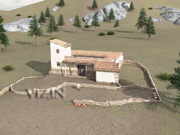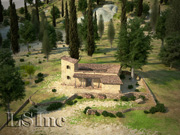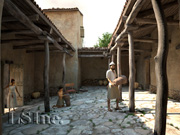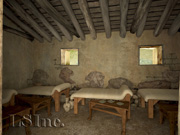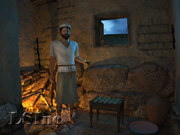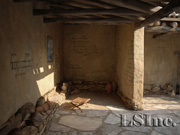Vari House Greece |
 The Vari House educational package was a research and development project that explored possible formats for a new type of teaching tool. Students were given information about the site as if they were archaeologists accumulating data. Some of the information was in two virtual worlds (one of the site as excavated and one as reconstructed), either apparent when one navigated through the virtual world, or linked at hot spots to be discovered. Other information was in linked text about such topics as the geography of the area, history of the area, history of ancient Greek culture, the religion of the period, and other topics. The ultimate goal was for the student to formulate a theory of the building’s original function (farmhouse, specializing in beekeeping) and to find evidence for its dating (Hellenistic, c. 325–275 BCE).
The Vari House educational package was a research and development project that explored possible formats for a new type of teaching tool. Students were given information about the site as if they were archaeologists accumulating data. Some of the information was in two virtual worlds (one of the site as excavated and one as reconstructed), either apparent when one navigated through the virtual world, or linked at hot spots to be discovered. Other information was in linked text about such topics as the geography of the area, history of the area, history of ancient Greek culture, the religion of the period, and other topics. The ultimate goal was for the student to formulate a theory of the building’s original function (farmhouse, specializing in beekeeping) and to find evidence for its dating (Hellenistic, c. 325–275 BCE). click on the images to enlarge
A Sampling from the Vari House Teaching Package
Problem-solving tasks, which form the core of the Vari House teaching package:Next time, leave a note..
![]() How do you tell how old something is?
How do you tell how old something is?
It would be nice to find a note that read: "This building was built in the year so and so, by these people, for this reason," like a cornerstone on some modern buildings, or like the information found on architects' drawings. Rarely, if ever, are these types of documents preserved in the archaeological record. Rarely did people bother to write down such information.
![]() So, what is left that can provide dates?
So, what is left that can provide dates?
 Some objects do have dates or datable information, on them, such as coins. Sometimes an object is similar to one from another site that has been securely dated; if they are similar enough, then archaeologists assume the two artifacts were made around the same time.
Some objects do have dates or datable information, on them, such as coins. Sometimes an object is similar to one from another site that has been securely dated; if they are similar enough, then archaeologists assume the two artifacts were made around the same time.
Location of artifacts can give information, too. A datable artifact found underneath a floor or a wall must have been there before the floor or wall was built. Thus we can date that floor or wall after the known date of the object. This kind of layering that occurs over time is called the of the site.
When all the artifacts found in association with a building and found in relation to each other are studied and compared, a range of likely dates for the building can be suggested.
Building construction details and spatial organization, again in comparison to other datable buildings, also provide clues to a structure's date.
Written records from the time the building was built sometimes survive. For a period over 2000 years ago this may seem unlikely, but fortunately some ancient Greek writings have come down to us. Through the ancient Roman times, the Medieval period, and into our modern period, these writings were copied, preserved, consulted, and translated. When written sources from the time tell us something about a town or a building, the archaeologists' task becomes comparing the excavated physical evidence with the written evidence, checking each against the other.
Dating the Vari House
Archaeologists recognized that the materials and layout of the building at Vari were similar to those in houses from the period of ancient Greece. The excavators could be more specific about the date of the building because they were lucky enough to find some datable pottery in the debris underneath the dirt floor of one of the rooms. The date of these fragments gives us the earliest possible date for the building because the objects were found under the floor. Therefore, they must have been in use before the floor was laid down, and thus the floor, and the actual occupation date, must be later than the fragments.
The excavators could be more specific about the date of the building because they were lucky enough to find some datable pottery in the debris underneath the dirt floor of one of the rooms. The date of these fragments gives us the earliest possible date for the building because the objects were found under the floor. Therefore, they must have been in use before the floor was laid down, and thus the floor, and the actual occupation date, must be later than the fragments.
Evidence for the latest possible occupation date for the building was found elsewhere in one of the rooms.
Find the evidence yourself for the earliest possible date and the latest possible date.
![]() What are those dates?
What are those dates?
![]() What then is the rage of likely dates that the building could have been built and used?
What then is the rage of likely dates that the building could have been built and used?
![]() Can you think of some ways to be more precise about how long the building was occupied?
Can you think of some ways to be more precise about how long the building was occupied?
![]() What objects were found in the building and what was missing?
What objects were found in the building and what was missing?
![]() Which parts of the building might show evidence of being used by being worn away?
Which parts of the building might show evidence of being used by being worn away?
Following are some of the reasons why archaeologists believe that the Vari House was in use only for a relatively short time:
- Archaeologists determined that there was only one floor level in the building, and since dirt or earth floors need to be repaired and relaid periodically, this evidence indicates a brief occupation.
- The archaeologists found no evidence of major rebuilding phases or additions to the building, which would be expected over a long period of use.
Can you think of another reason why it seems that the building was not used for many generations? Think about what kinds of objects were found in the building and what kinds -- that we would expect to find in a long-occupied house -- were not found. Have you found the element on the interior of the building that was not very worn, telling the excavators that the building was not used for a very long time?
![]()
![]()
![]()
A Sampling of background material and study questions from linked texts:
Environment and Resources in Ancient GreeceEnvironmental studies, such as pollen analysis, indicate that up until the last century conditions had not changed all that much since Classical times. Modern mechanization has brought more change in the past 100 years than in the previous 2000 years combined. Although the climate may have changed somewhat since ancient times, we can assume that it is not greatly different from today's climate. Southern Greece, including Attica and the Peloponnesus has warm, wet winters, and hot, dry summers with plenty of sunshine. Northern Greece is subject to colder, windier winters, when it snows often in the mountains and less often near the coastlines; summers are warm and sunny.
What was the landscape like that people had to work with and live in? Greece is extremely diverse, and even a small region might include an interesting variety of land and plant features. One hardly expects, when climbing a rocky and barren hill, to find a lush and watery reed-bed on the other side, but such transitions are found.
Common landscape features include isolated plains, or basins filled with silt, that are most suitable for growing foods like grain. There are also soft hills where olive trees can be grown on human-made terraces. The numerous mountains and many hills are of hard limestone that support wild plants but cannot be cultivated. Studies suggest that meadows and marshes were more common in the Classical landscape than today.
The average plant community does not include miles of unbroken forest; rather, there are pockets of woods containing coniferous and deciduous trees, especially in the north and west parts of the country, which are fairly wet. In the dry southeast, however, trees large enough to produce timber are rare. Many plants are low-growing shrubs, undershrubs, and grasses that blanket the rugged and often rocky terrain with soft colors. The undershrubs are rich in wild plants that are edible and are especially liked by honey-producing bees.
In lowland areas of Greece (that is, below the mountains, which are often snow-peaked), frosts are rare. Although large amounts of rain can fall in wintertime, the bedrock is porous, so water is not easily retained in the ground. This means that although river and stream beds are plentiful, few have water running in them all the time.
This diversity greatly affected the way that people could live off the land. Most everybody had access to uplands for pasturing sheep and goats, stone for constructing buildings, and soil for making mudbrick. Beyond these basics, however, important resources were not available everywhere.
It happens that many important poleis like Athens, Sparta, and Corinth were located in semi-arid areas. Obtaining timber for construction was therefore a big concern and required trading with areas in the north and in Asia Minor. Attica was especially well suited to olive-growing and traded oil for things it lacked in abundance, like timber and wheat. The neighboring territory of Boeotia (pron: bee-oh'-sha), on the other hand, had more extensive plains for growing grain.
We begin to see that resources were not distributed equally throughout the landscape, and this helps to explain the variety of sites encountered. Complete self-sufficiency would have been difficult for the average farmer, and villages and small towns provided networks for trade so that everyone could acquire the things they needed.
The local environment and resources in any give area of the countryside had a direct affect on a region's economy, right down to a day in the life of a farmer: at harvest time in the terraced hills, residents of a household might spend their day beating olives from the trees, while harvest time in the lowland plains meant bundling wheat stalks in preparation for the long process of threshing and grinding.
click on the images to enlarge![]() Have you discovered yet what the residents of the Vari House specialized in and what they may have used for trade?
Have you discovered yet what the residents of the Vari House specialized in and what they may have used for trade?
![]() What is the land like outside the town or city where you live? What foods does it produce?
What is the land like outside the town or city where you live? What foods does it produce?
![]() Does it produce for local consumption only, or does your area produce foods to send to other areas?
Does it produce for local consumption only, or does your area produce foods to send to other areas?
![]() Of the foods in your refrigerator or on the shelves at your home, which were produced nearby?
Of the foods in your refrigerator or on the shelves at your home, which were produced nearby?
![]() How dependent is your local economy on items produced far away?
How dependent is your local economy on items produced far away?
![]() If your area has cold winters, where do the fresh fruits and vegetables come from in winter?
If your area has cold winters, where do the fresh fruits and vegetables come from in winter?
Reference
Page Created: December 12, 2004
Page Updated: January 5, 2012
URL:
Page Author: The Institute for the Visualization of History
